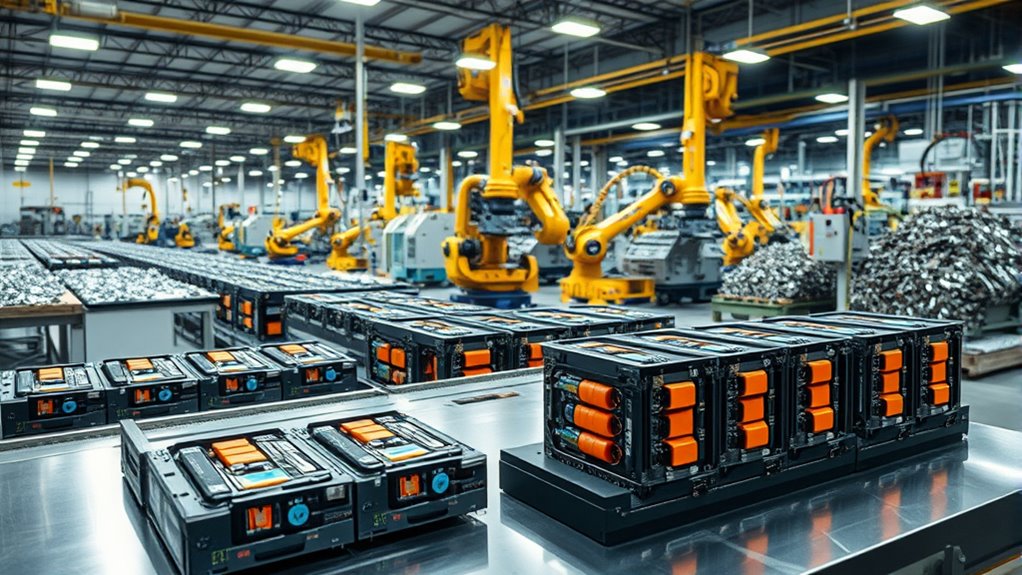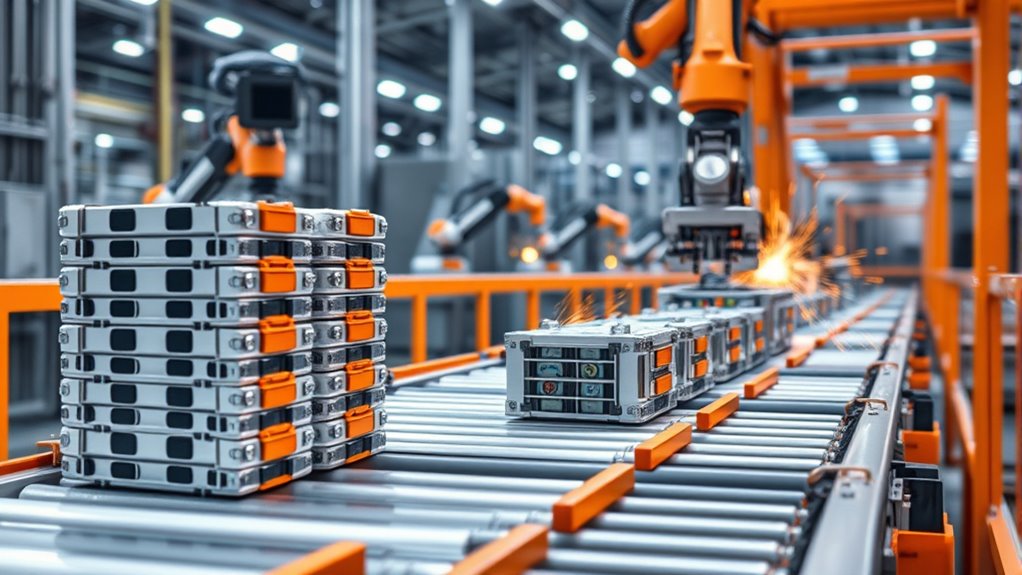You can help support a sustainable EV industry by understanding how lithium-ion battery recycling and reuse keep the cycle going. Reusing batteries extends their life and conserves raw materials like lithium and cobalt, but evaluating their health accurately remains a challenge. Advances in recycling technology aim to recover more materials efficiently and safely, reducing environmental impact. If you want to learn how these innovations are shaping a closed-loop system for batteries, keep exploring the key developments.
Key Takeaways
- Developing reliable testing protocols ensures used EV batteries are safely repurposed or recycled.
- Innovations in recycling technologies aim to improve material recovery efficiency and reduce environmental impact.
- Second-life batteries extend utility, delaying recycling and conserving critical raw materials like lithium and cobalt.
- Integrating reuse and recycling creates a circular battery lifecycle, supporting sustainable EV industry growth.
- Advanced sorting and processing methods address challenges posed by diverse battery chemistries and designs.

Have you ever wondered what happens to electric vehicle batteries once they reach the end of their lifespan? When a battery has exhausted its usefulness in a vehicle, it doesn’t necessarily mean it’s destined for the junkyard. Instead, many batteries can be repurposed through battery reuse, extending their life before recycling becomes necessary. Battery reuse involves testing these batteries to see if they still hold enough charge for less demanding applications, like energy storage for homes or grid support. This process helps maximize the value of each battery and delays the need for recycling, which is vital given the limited supply of raw materials like lithium, cobalt, and nickel.
End-of-life EV batteries can be reused for energy storage before recycling, extending their lifespan and conserving vital raw materials.
However, battery reuse isn’t without its challenges. The main obstacle is accurately evaluating the health and capacity of used batteries. Over time, batteries degrade unevenly, making it difficult to determine whether a second life is viable. Without reliable testing protocols, there’s a risk of deploying batteries that might fail prematurely or pose safety hazards. Additionally, as more batteries reach the end of their initial lifecycle, the logistics of sorting, testing, and repurposing them become increasingly complex and costly. This is where recycling challenges come into play. Recycling lithium-ion batteries involves breaking down the components to recover valuable materials, but the process is complicated by the diversity of battery chemistries and designs.
One of the biggest recycling challenges is safely dismantling these batteries. They contain flammable electrolytes and potentially hazardous materials, so handling them requires specialized equipment and strict safety protocols. Furthermore, current recycling technologies often struggle to recover materials efficiently and economically, especially with small or contaminated batteries. This leaves a significant percentage of valuable materials unrecovered, which, in turn, hampers the sustainability of the entire supply chain. Improving recycling efficiency is critical to closing the loop on lithium-ion batteries.
Despite these hurdles, advancements are underway. Researchers are developing better testing methods for battery reuse, and new recycling technologies are being designed to improve material recovery rates. The goal is to create a closed-loop system where batteries are reused as long as possible, then recycled efficiently at the end of their second life. This approach helps reduce environmental impact, lowers reliance on mining, and supports the growth of a sustainable electric vehicle industry. So, while battery reuse and recycling challenges are real, ongoing innovation promises a future where EV batteries can be fully integrated into a circular economy, closing the loop on lithium-ion and making electric mobility truly sustainable.
Frequently Asked Questions
How Long Do EV Batteries Typically Last Before Recycling?
Your EV batteries typically last between 8 to 15 years, depending on usage and maintenance. The battery lifespan influences when recycling happens, which usually occurs after significant capacity loss or end-of-life. The recycling timeline can vary, but ideally, it begins soon after the battery’s performance declines, ensuring valuable materials like lithium and cobalt are recovered efficiently. This process helps close the loop, benefiting both the environment and resource sustainability.
What Environmental Impacts Are Associated With Battery Recycling Processes?
You should know that battery recycling processes can pose environmental impacts like chemical hazards from toxic substances, which may contaminate soil and water if not properly managed. Waste management is vital, as improper handling can lead to hazardous waste buildup. To minimize these effects, recycling facilities must follow strict safety protocols, guarantee safe disposal of chemicals, and aim for sustainable practices that reduce environmental harm.
Are Recycled Lithium-Ion Batteries as Efficient as New Ones?
Like a well-tuned engine, recycled lithium-ion batteries can be nearly as efficient as new ones, but it depends on recycling efficiency and battery lifespan. You might notice a slight drop in performance initially, yet advances are closing this gap. Proper recycling processes help preserve battery capacity, ensuring that recycled batteries serve you well. Overall, they’re a sustainable choice that keeps performance reliable while reducing environmental impact.
How Do Recycling Costs Compare to Manufacturing New Batteries?
Recycling costs are generally lower than manufacturing new batteries, enhancing cost efficiency and supporting a more sustainable supply chain. By reusing valuable materials from used batteries, you reduce raw material expenses and energy consumption. This process helps stabilize prices and lessen dependence on mining. Overall, recycling offers a cost-effective way to meet demand while minimizing environmental impact, making it a smart choice for long-term battery production.
What Innovations Are Emerging in EV Battery Recycling Technology?
You’ll see innovations like second life applications, where used EV batteries find new uses, extending their life and delaying recycling. Sustainable processing methods are also advancing, reducing environmental impact and improving efficiency. These innovations help streamline recycling, lower costs, and promote circular economy practices. By adopting these new technologies, you can contribute to more eco-friendly solutions while maximizing battery value throughout its lifecycle.
Conclusion
As you navigate the future of EVs, think of battery recycling as tending a delicate garden, where every leaf and root is carefully repurposed to nurture new growth. By embracing responsible recycling, you help transform what once seemed like waste into a vibrant cycle of renewal. This gentle process ensures the journey continues smoothly, turning the once-hidden remnants into the foundation of tomorrow’s cleaner, brighter roads—where sustainability blossoms with each mindful step you take.








